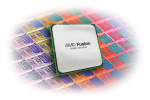5. Metodologia di prova
Â
Per testare le prestazioni della APU AMD A8-3850 abbiamo allestito una piattaforma con una scheda madre ASRock A75 Pro4, un kit di memoria Corsair Dominator GT 1600 ed una scheda video Sapphire Radeon HD 6670 Ultimate per i test in configurazione Dual Graphics.
Di seguito, le configurazioni testate:
- AMD A8-3850 con scheda madre AMD A75
- AMD A8-3850 con scheda madre AMD A75 e scheda video Radeon HD 6670 in Dual Graphics
- Intel Core i3 2100 con scheda madre Intel H67
- Intel Core i3 2100 con scheda madre Intel H67 e scheda video Radeon HD 6670
- Intel Core i7 2600K con scheda madre Intel H67
- Intel Core i7 2600K con scheda madre Intel H67 e scheda video Radeon HD 6670
- AMD Phenom II X4 970 con scheda madre AMD 990FX e scheda video Radeon HD 6670
Â
Per valutare lâimpatto della frequenza delle memorie sulle prestazioni della APU A8-3850, abbiamo eseguito i test con queste due impostazioni:
- 1333 MHz Timings 9 9 9 24 1T
- 1600 MHz Timings 7 7 7 21 1T
Per le altre piattaforme inserite nella comparativa sono state utilizzate memorie impostate a 1333 MHz con latenze pari a 9 9 9 24 1T.
Â
Â
Benchmark
La suite di benchmark è stata estesa e modificata per meglio individuare le differenze prestazionali tra le CPU tradizionali e le nuove APU AMD.
Compressione
- 7-Zip 64 bit
- WinRARÂ 64 bit (Multi Threads, Single Thread)
Rendering
- MAXCON Cinebench R11.5 64 bit (GPU, Threads, Single Thread)
- POV-Ray 3.7 RC3 64 bit
Sintetici
- PassMark Performance Test 64 bit (CPU, 3D, Memory)
- Futuremark PCMark Vantage 64 bit
- Super PI 1M
Grafica 3D
- Futuremark 3DMark 11 DX11 64 bit (Entry, Performance)
- Futuremark 3DMark Vantage DX10 32 bit (Entry, Performance)
- Tom Clancyâs H.A.W.X. DX10.1 32 bit (AA2x, SSAO Basso)
- Resident Evil 5 DX10 32 bit (NO AA, Motion Blur OFF)
Â
Â









